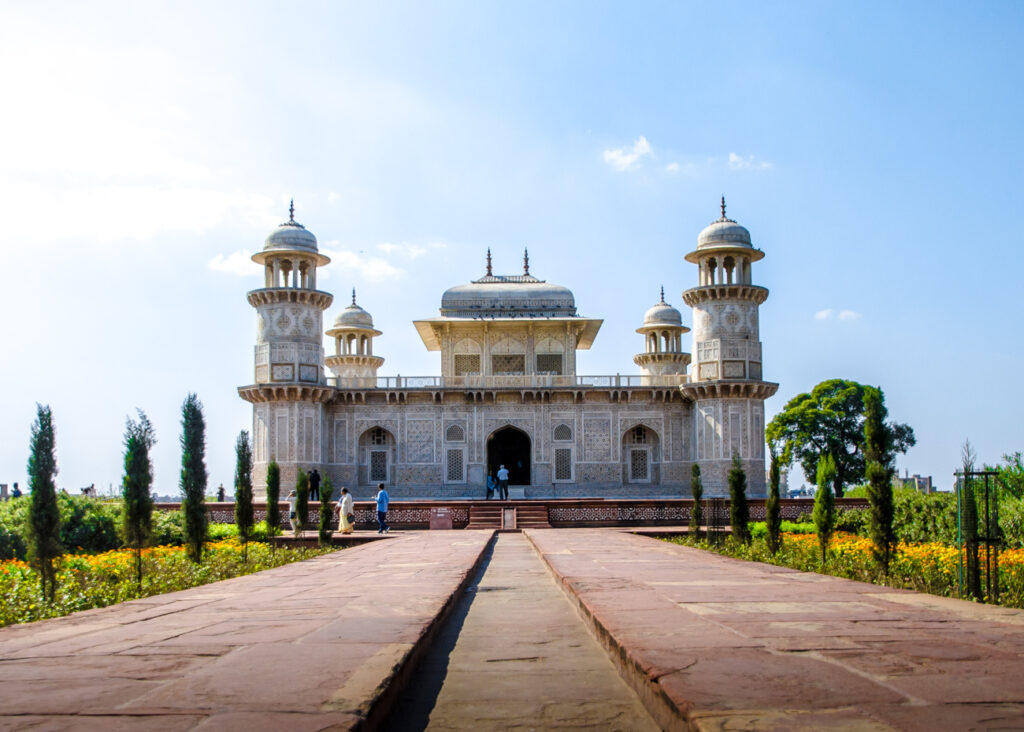Disclosure: This post contains affiliate links that I may earn a small commission from if you purchase something through them. This comes at no extra cost to you!
Not far from the world famous Taj Mahal lies the majestic Baby Taj, quietly sitting on the banks of the Yamuna River in Agra, India.
There’s no debate over the fact that the main attraction in Agra is the magnificent Taj Mahal, but this smaller and lesser-known Taj is well worth stopping at in the city as well.
In the Uttar Pradesh region of northern India, the Tomb of Itmad-ud-Daulah (also called the ‘Baby Taj’ or ‘Jewel Box’) has all the beauty and craftsmanship of the Taj Mahal, except that it doesn’t attract the hoards of tourists that the Taj Mahal does.
In fact, I found that’s actually one of the highlights of visiting the Baby Taj in itself; it’s so much quieter! You’ll have wide open space and room to explore at your leisure without thousands of people photo-bombing, which is something that is hard to come by as a tourist in India!
In this guide I’ll explain the history behind the Baby Taj and show you the best bits of a visit, including all the information you need to know before you go and some photography from my experience.
Table of Contents...
Toggle
Useful information for Agra
- Country: India
- Population: Agra = 2.2 million
- Language: Both Hindi and English are widely spoken across India.
- Currency: Indian rupees (INR). £1/$1 = 100/82 INR
- SIM cards: I highly recommend getting a SIM card for your travels in India. This means you can use apps like Uber or Ola for cheaper taxi fares but it also means you’re always connected to the world, never needing to rely on WiFi. Get an E-SIM here: India: eSIM Roaming Mobile Data Plan
- Visa info: Getting into India isn’t the most straight forward process. Unless you’re Indian, you’ll need to apply for an E-visa before arriving in India.
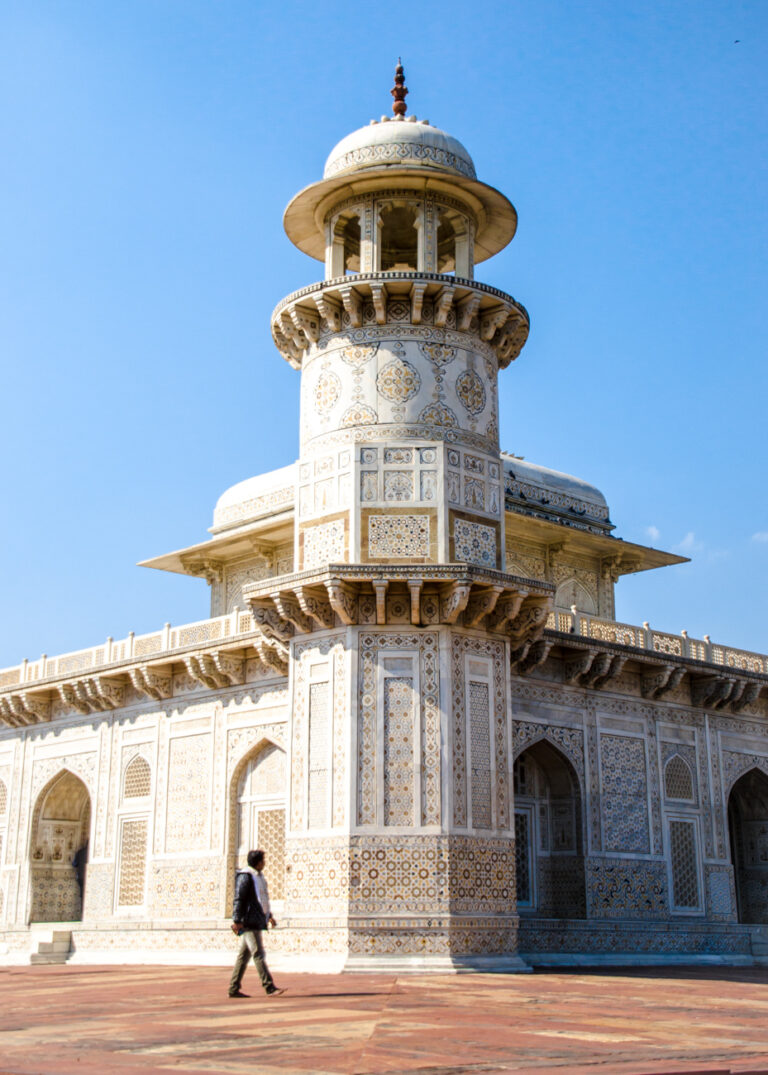
A brief history of the Baby Taj
Construction of the Tomb of Itmad-ud-Daulah started in 1622 and took 6 years to build. It wouldn’t be until 5 years later than construction of the Taj Mahal would begin, eventually being completed a quarter of a century after the the Baby Taj was.
Empress Nur Jahan had it constructed for her father Ghiyas Begh, who was ‘Itmad-ud-Daulah’ (a title meaning ‘pillar of the state’). She was also the aunt of Muntaz Mahal (the person who the Taj Mahal was later built for) and it is said that the design of the Taj Mahal was inspired by this structure.
Upon completion, it became the first Mughal tomb made purely from marble, and the first tomb to be built on the river Yamuna. Before that, tombs were made from sandstone with marble only as a decoration.
Where is it
Check it out on the interactive map below.
How to get there
To get to the Baby Taj you have three main options.
- Uber or Ola
India has two ride-share apps: Uber and Ola. This is the option I recommend and a ride should cost around just 250 INR from the city. With Uber you don’t need to worry about magical price changes and scams like you would in a taxi because payment is usually made automatically through the App.
- Book a tour
The most comfortable yet most expensive option is to book a small group tour. Guided tours are a great way to get around, especially somewhere as crazy as an Indian city. Travel in an air conditioned vehicle with a knowledgeable local guide and learn lots during the day. Not only will you stop at Baby Taj, but you’ll cram in many other sights along the way too.
Companies like GetYourGuide and Viator offer great tours in Agra.
- Taxi or rickshaw/tuktuk
Rickshaws may offer a cheaper price than Grab or Ola, but I had some problems in India where I would reach my destination and they would ask for more money, causing an issue. They also like to try and stop at their friend’s shops to encourage you to buy souvenirs and things like that.
When to go
The best time to visit Agra is in the winter, between December and February. This will avoid the monsoon rains from June to October and the intense heat from March to June. After March the crowds will be even bigger than normal and the temperature becomes so hot that it’s close to unbearable.
- Winter is late November to February
- Summer is March to May
- Monsoon season is June to October
Expected costs
For foreigners the entrance fee is 110 INR (£1.10) and for Indians it is just 10 INR.
How long to allow
To see everything on offer at the Baby Taj, I’d recommend a minimum stay of 30 minutes and a maximum of 1 hour. The area is small and won’t take you long to complete.
What to expect at the Baby Taj
After you’ve got your tickets at the gate, head through the main entrance which is a large red sandstone gate decorated with marble.
Passing the walls and entering the grounds of the Baby Taj is a proper breath of fresh air. You enter a typical Mughal charbagh (a square garden bisected by water channels) and are greeted with beautiful flower beds in systematic arrangements and, of course, the picturesque mausoleum directly ahead of you.
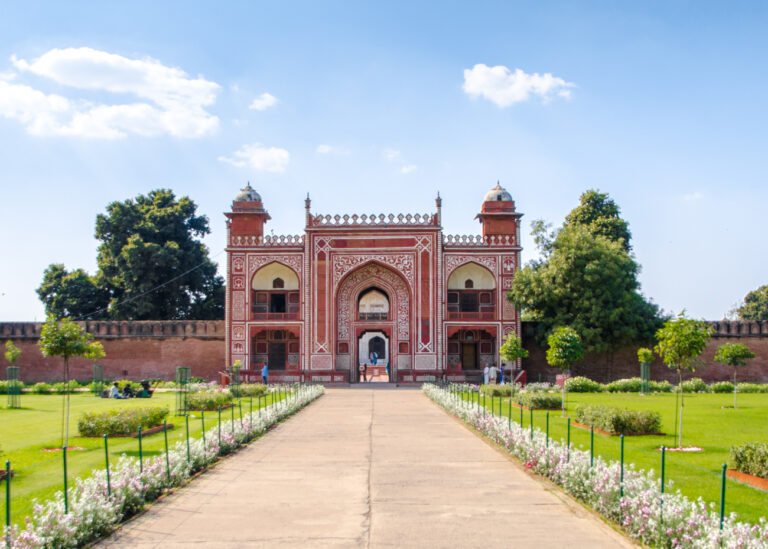
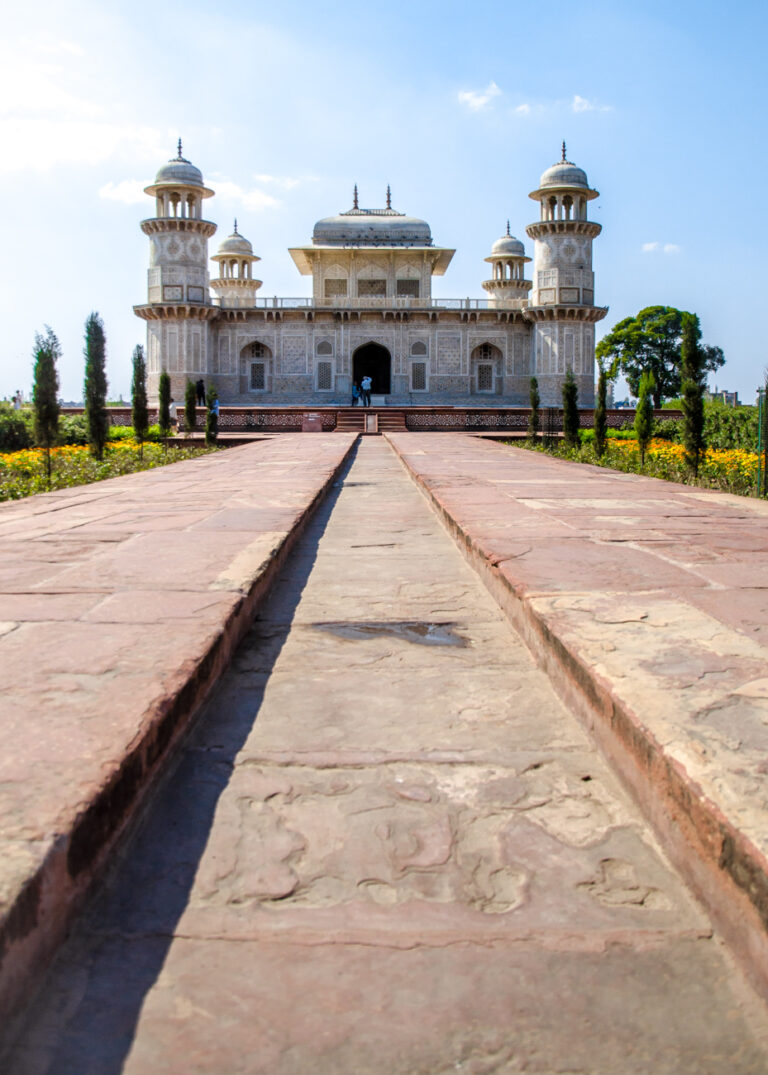
The mausoleum itself covers about 23m² and is made entirely of white marble, the first tomb like this during the Mughal era. Most others were built from red sandstone, something you’ll see a lot of in India!
The jaw-dropping Islamic architecture is what you come here to see, and the symmetrical minarets, arched entrances and striking white marble colours are simply stunning.
Walk around the area to see the tomb from all four sides before heading inside, welcoming the shade.
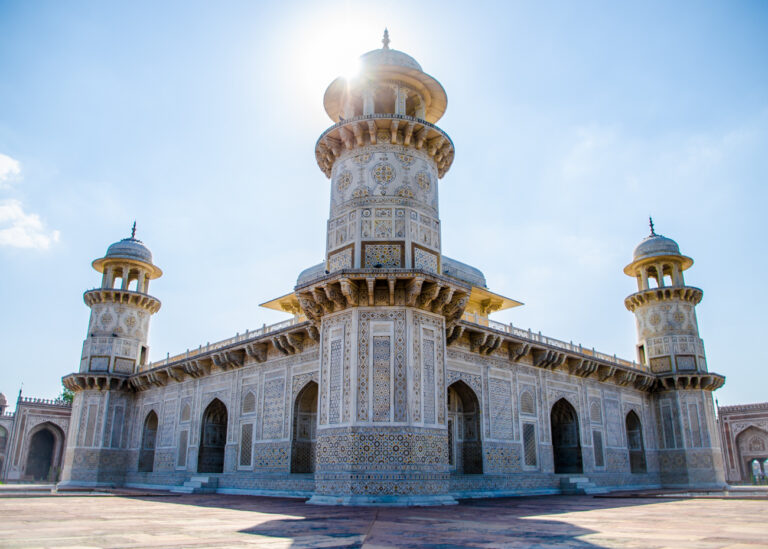
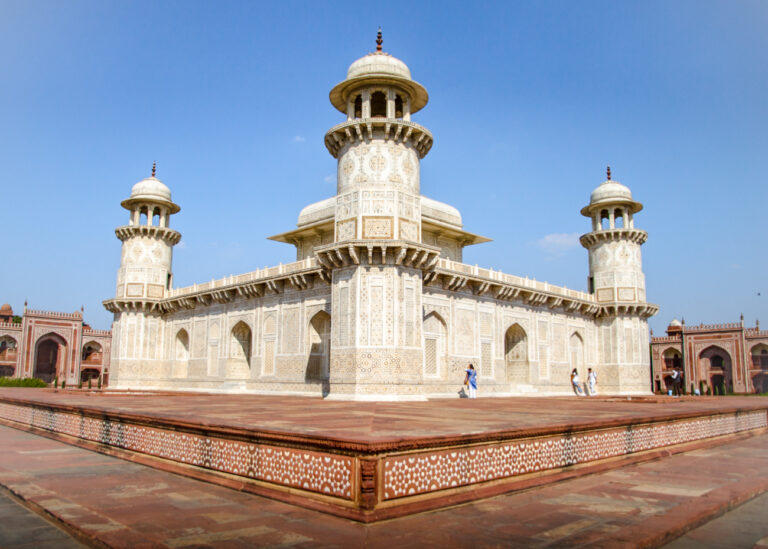
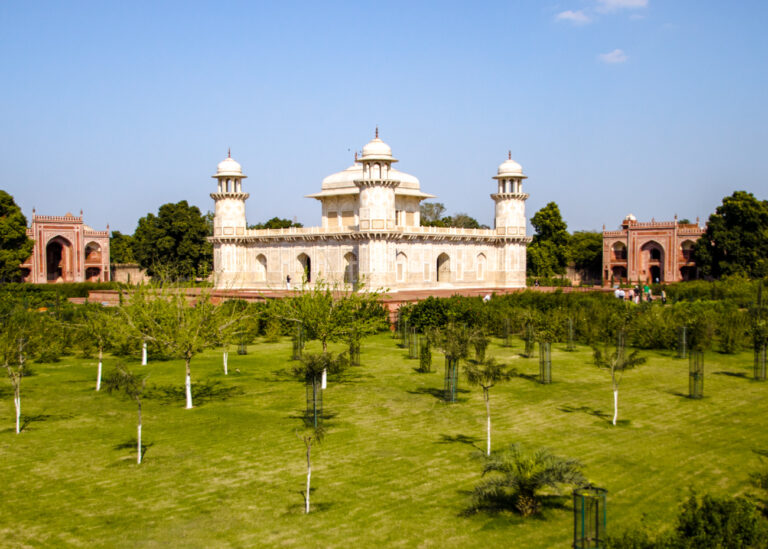
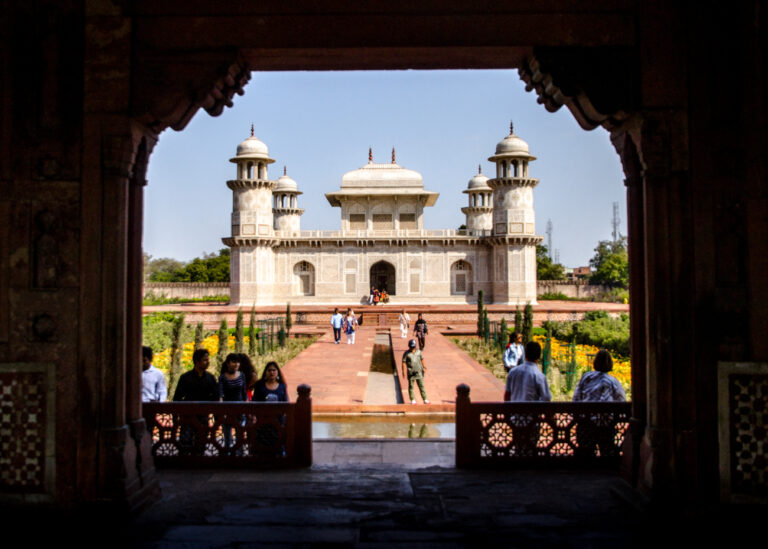
Inside there admittidly isn’t ‘that much’, but you’ll find intricate paintings and patterns in a range of different colours, as well as the tombs themselves and some white-marble carvings. Make sure to get up close and spend some time examining the designs.
To enter the mausoleum you must remove your shoes or you can rent shoe covers for 10 INR.
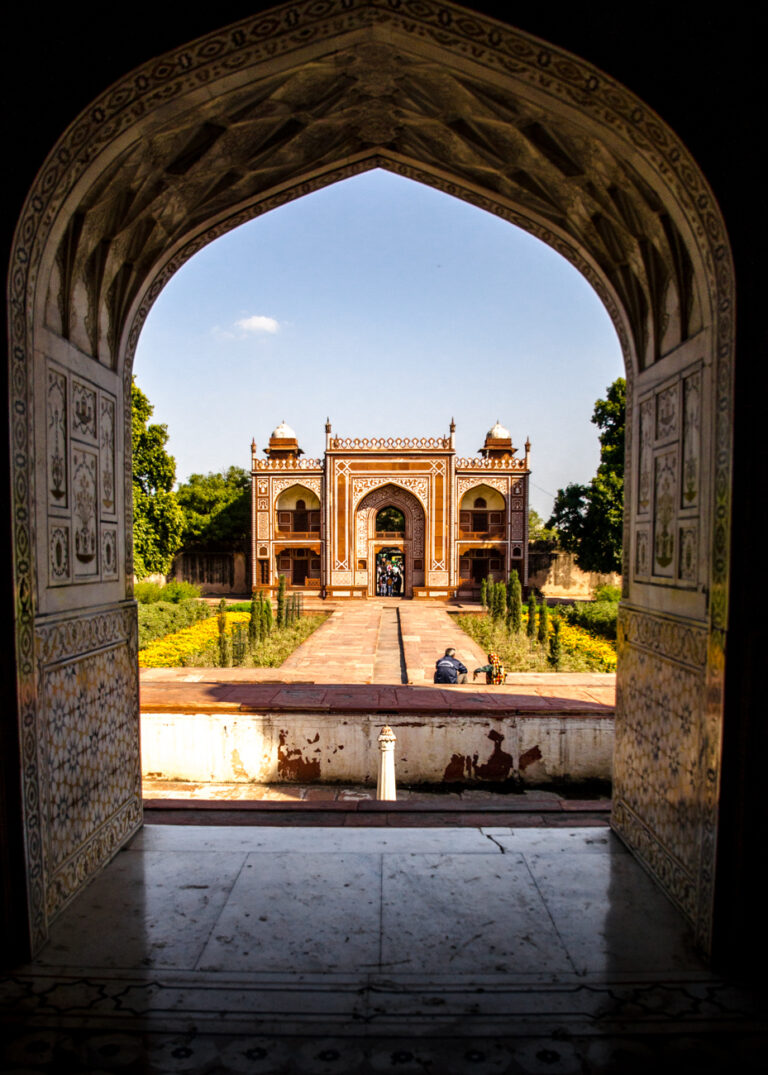
Unfortunately though, this historical monument is seemingly not maintained very well, which is quite sad considering its historical significance and not to mention the fact that there are entrance fees. Marble has been chipped off over time and street dogs freely wander around the complex, unlike the Taj Mahal! It makes you wonder who’s pockets that money goes into, because it sure doesn’t go into maintaining the Baby Taj!
After around 30-60 minutes of exploring the gardens and examining the details, you’ll probably be ready for a change of scene. Time to face the busy streets of Agra once more!
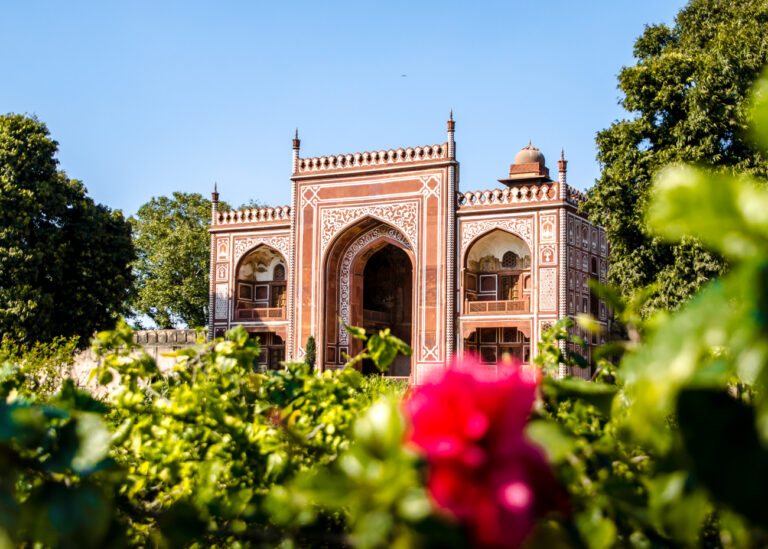
Where to stay in Agra
Affordable accommodation is something India does very well, and in Agra you’re spoiled for choice.
Browse Booking.com and Hostelworld for the best rates in town.
Packing essentials
International adapter: Check out options here. Most of the best adapters are set up to work in every country in the world and have multiple USB sockets so you can charge more than one gadget at a time.I use this one: MyTravlPal.
Travel camera: Pack a compact travel camera to take nicer photos than a phone and document your time in Agra. I use this one which, for me, is an essential item everywhere I go.
Water: Make sure you pack a reusable water bottle and plenty of water as it will likely be a sweaty day.
Portable charger: You’ll be taking lots of pictures around Agra so pack a portable charger to charge your phone and devices on the move.
Hat, sunscreen and sunglasses: Gotta’ stay protected!
Best tours in Agra

Thank you for reading this travel guide – I hope you found it helpful! Feel free to leave a comment below if you have any questions and I’ll get back to you as soon as possible
Happy travelling!
HELPFUL RESOURCES FOR PLANNING YOUR TRIP
Accommodation: Booking.com, Hostelworld
Tours: GetYourGuide, Viator, Klook, TripAdvisor
Transport: 12Go, Omio, Trip.com, Rome2Rio
WHO IN THE WORLD IS JAMES?
Click below to learn more about my story, including 5 random facts about me, some travel FAQ’s and my entire travel history.

